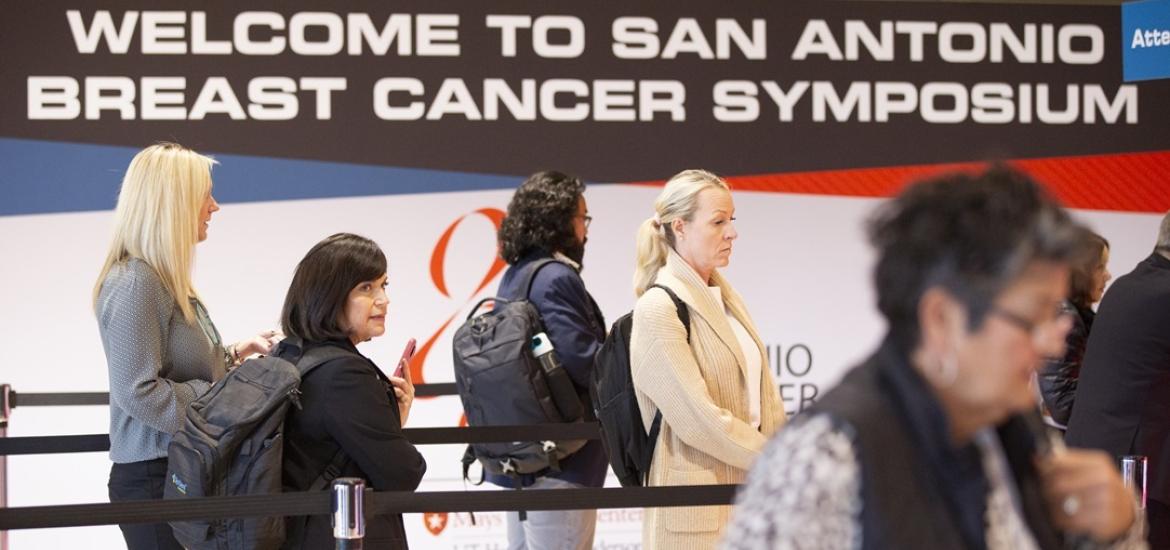
SABCS 2023 – SERDs square off in combinations
Arvinas’s SERD appears to edge out Olema’s, but what’s the best CDK4/6 inhibitor for a phase 3 combination?
Arvinas’s SERD appears to edge out Olema’s, but what’s the best CDK4/6 inhibitor for a phase 3 combination?

While Arvinas and Olema have both taken their SERD breast cancer projects into phase 3 monotherapy trials on some pretty flimsy data, a separate battle is under way to find which of them will do best in combination with a CDK4/6 inhibitor.
At the San Antonio Breast Cancer Symposium the companies highlighted this effort, Arvinas combining vepdegestrant with Pfizer’s Ibrance, and Olema presenting two palazestrant combo studies, one with Ibrance and the other with Novartis’s Kisqali. The datasets are very early, but Arvinas seems to have the upper hand in a possibly sicker population, leaving Olema to talk up safety.
In monotherapy the early SERD (selective oestrogen receptor degrader) battle saw Menarini’s Orserdu US approved in January, with AstraZeneca’s camizestrant succeeding clinically while Roche’s giredestrant and Sanofi’s amcenestrant failed. But the combo space is important for Arvinas and Olema, as it backs the bull case that each might be bought by a company with a breast cancer presence.
Arvinas might be betrothed to Pfizer, since the latter is already the licensee for vepdegestrant. However, Pfizer’s Ibrance is being edged out by Novartis’s Kisqali, so it's important for Olema to combine palazestrant – which it wholly owns – with the Novartis drug, as it plans to in phase 3.
But Arvinas is not to be outdone, revealing that it isn’t tied solely to Ibrance combos. A phase 3 trial combining vepdegestrant with Pfier’s CDK4-specific inhibitor PF-07220060 is planned, it told an investor call today.
Combo data
As for the actual SABCS combo datasets, it’s probably fair to say that neither was outstanding, and while Arvinas lost 4% yesterday Olema was off 15% – though the latter company is still sitting on a more than quadrupled share price year to date. After today's investor call, however, Arvinas surged 20%.
Arvinas/Pfizer’s Veritac trial, whose monotherapy cohort disappointed a year ago, showed a 42% ORR, with 11.1 months of median PFS, for an Ibrance combo. The important takeaways here are that activity was similar in patients with and without an ESR1 mutation, and that neutropenia, a troubling toxicity, was seen in 48% of patients at grade 3 and in 41% at grade 4.
It’s on neutropenia that Olema claims to have the upper hand, and its Ibrance combo trial showed arguably lower levels: 61% grade 3, and 11% grade 4. On efficacy, however, Olema had less to shout about, reporting just seven partial remissions (five unconfirmed) among 32 evaluable subjects – similarly split between ESR1 mutant and wild-type disease.
Meanwhile, the Kisqali/palazestrant combo has shown one partial remission in an ESR1m patient, among the first 19 treated so far, but it’s very early days.
Olema talked up the “clinical benefit rate” for the Ibrance combo, saying this compared favourably against historical controls, but it didn’t reveal any PFS data.
Cross-trial SERD* comparisons in ER+ve HER2-ve breast cancer
| Olema | Arvinas/Pfizer | |
| Palazestrant | Vepdegestrant | |
| Ibrance combo | ||
| Trial | NCT05266105 | Veritac |
| Baseline | Median 1 prior line, 72% post CDK4/6i | Median 3 prior lines, 87% post CDK4/6i |
| Efficacy | ORR 22% (n=32 evaluable) | ORR 42% (n=31 evaluable) |
| ORR 23% in ESR1m, 24% in ESR1w/t | ORR 47% in ESR1m, 42% in ESR1w/t | |
| Neutropenia | 87% (incl 61% gr3, 11% gr4) | 100% (incl 48% gr3, 41% gr4) |
| Kisqali combo | ||
| Trial | NCT05508906** | (none) |
| Baseline | Median 2 prior lines, 89% post CDK4/6i | |
| Efficacy | 1 PR, 4 SD (n=19 treated) | |
| Neutropenia | 58% (incl 37% gr3, 0% gr4) | |
| Phase 3 | ||
| Monotherapy | Opera-01 | Veritac-2 |
| 2nd to 3rd line, PFS primary | 2nd line, PFS primary | |
| Combo | (none) | Veritac-3 |
| 1st-line Ibrance combo, PFS co-primary | ||
| Future ph3 combo | 1st-line Kisqali or Ibrance combo possible in late 2024 | PF-07220060 combo possible after 2024 feedback |
Notes: *Olema says palazestrant is an ER antagonist as well as a SERD, while Arvinas calls vepdegestrant a Protac ER degrader; **will also test a combo with Piqray. Source: SABCS & company presentations.
Investors will scrutinise these datasets to gauge each company’s chances of success in phase 3, where Olema has so far taken only palazetrant monotherapy; based on phase 1 its chances of success seem low. Rather, the focus will be on a combo with Kisqali, though Olema told the recent Jefferies London healthcare conference that such a pivotal trial was dependent on more funding.
Arvinas’s phase 3 vepdegestrant monotherapy study, Veritac-2, tests a slightly earlier setting than Olema’s, and its Veritac-3 Ibrance combo trial is already under way. Even if that company has tied itself to the less preferred CDK4/6 inhibitor, the prospect of a future combo with Pfizer’s CDK4 inhibitor PF-07220060 offers some redemption, though this agent is still an unknown quantity.
2132













